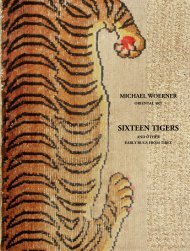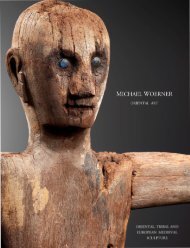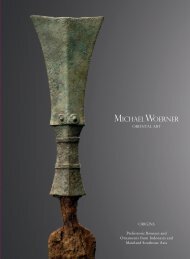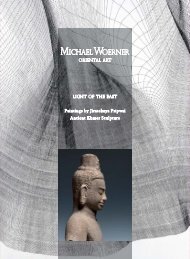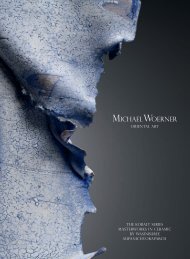You also want an ePaper? Increase the reach of your titles
YUMPU automatically turns print PDFs into web optimized ePapers that Google loves.
Michael Woerner<br />
ORIENTAL ART<br />
EARTHEN BEAUTY<br />
Masterpieces of Early Thai Ceramics<br />
from the Dr. Kurt Sandmair Collection
<strong>MICHAEL</strong> <strong>WOERNER</strong><br />
<strong>Oriental</strong> <strong>Art</strong><br />
<strong>2018</strong><br />
1
M i c h a e l Woerner<br />
<strong>Oriental</strong> <strong>Art</strong> <strong>2018</strong><br />
EARTHEN BEAUTY<br />
Masterpieces of Early Thai Ceramics<br />
from the Dr. Kurt Sandmair Collection<br />
Bangkok · Hong Kong<br />
By appointment<br />
Tel. +66-89-224.9678<br />
micwoerner@yahoo.com<br />
3
Dr. Kurt Sandmair<br />
1932 – 2013<br />
4
After our widely acclaimed 2017 exhibition in <strong>Brussels</strong> of the KOBALT SERIES<br />
ceramics of contemporary Thai artist Wasinburee Supanichvoraparch (with a<br />
follow-up show in December 2017 in Hamburg, and three others in Europe and<br />
the U.S. in the planning), we return to <strong>CULTURES</strong> with a celebration of the<br />
roots of Thai ceramic art: Earthen Beauty – Masterpieces of Early Thai Ceramics<br />
from the Dr. Kurt Sandmair Collection.<br />
In his professional life Dr Kurt Sandmair was a well-known and highly respected<br />
patent and intellectual property lawyer in Munich. From early on he developed a<br />
passionate interest in the early cultures of Southeast Asia to where he travelled<br />
frequently from the mid-1960s onwards. He was in particular fascinated by the<br />
early ceramics of Mainland Southeast Asia. His extensive business contacts<br />
in Southeast Asia and his frequent visits to museums, art fairs and dealers in<br />
Europe and the U.S. encouraged him to acquire between the mid-1960s and<br />
the early 1980s one of the most significant collections of early Southeast Asian<br />
ceramics. Ready to share his knowledge he contributed to museum exhibitions<br />
and publications. Numerous examples from his collection are nowadays in the<br />
Five Continents Museum (the former Völkerkunde-Museum) in Munich, and<br />
the Museum für Asiatische Kunst in Berlin, as well as in other renowned private<br />
collections in Southeast Asia, Japan, Europe and the U.S.<br />
We are honored to showcase some 50 of the finest ceramics from his collection<br />
during <strong>CULTURES</strong> <strong>2018</strong> in <strong>Brussels</strong>. Our deep gratitude goes to Mrs I. Sandmair<br />
for making these wonderful objects available for publication and further studies.<br />
We take due diligence seriously: all ceramics in this catalogue have been crosschecked<br />
with the ART LOSS REGISTER, London.<br />
We look forward to seeing you in <strong>Brussels</strong>.<br />
<strong>MICHAEL</strong> <strong>WOERNER</strong><br />
<strong>Brussels</strong>, June <strong>2018</strong><br />
5
EARLY THAI CERAMICS<br />
FROM NEOLITHIC TO IRON AGE<br />
The beginnings of any form of art always confront us with one of the fundamental<br />
questions in life: Where do we come from ? Within the context of the<br />
Prehistory of Mainland Southeast Asia Prof. Charles Higham of the University<br />
Otago, New Zealand, must be credited with puzzling together the probably<br />
most concise history of development of our human species over a time span of<br />
two million years. His publication “Early Mainland Southeast Asia – From First<br />
Humans to Angkor” (River Books, Bangkok, 2014) offers in one single volume<br />
and in a brilliantly lucid language a fascinating journey through this period.<br />
Since 1969 Prof. Higham focused his research on the prehistory of Northeastern<br />
Thailand. With the advances of technology, and in particular with the application<br />
of Bayesian analysis of C14 determinations, he developed a precise timeline<br />
for several of the Northeastern Thai archaeological sites, spanning from the<br />
Neolithic of the early second millennium BCE, through the Bronze Age (circa<br />
1000 – 300 BCE) to the Iron Age (300 BCE – 200 CE).<br />
A substantial amount of our current knowledge about the first and second<br />
millennium BCE derives from the analysis of mortuary traditions. Numerous<br />
burial sites containing pottery vessels have been uncovered in Northeastern<br />
Thailand, the probably most significant, scientifically excavated site being Ban<br />
Non Wat, located in the Upper Mun Valley on the Khorat Plateau. Here, over<br />
a period of 600 years and about 25 generations, social changes can be analyzed<br />
from changes in mortuary traditions from the late Neolithic to the end of the<br />
Bronze Age.<br />
Above: Panorama view of the design on the Neolithic Cylindrical Vessel, p. 10-11.<br />
Page 7: Detail of Bowl with Human Figures, p. 44-45.<br />
6
Accidental surface finds of pottery shards in the early 1960s near Ban Chiang in<br />
Udon Thani province led to the discovery of a large funerary site and adjacent<br />
settlement which had been occupied from circa 1500 BCE to at least 200 CE.<br />
Thousands of pottery items have been unearthed over the years in numerous<br />
sites in Northern and Central Thailand, early on by the local villagers, later on<br />
in archaeological excavations. Most of these pottery items are stored in museum<br />
and private collections in Thailand and all over the world, bearing testimony to<br />
a significant period of human settlement in Southeast Asia.<br />
The earliest pottery wares are dating into the Neolithic<br />
period (circa 1800 – 1000 BCE), during which the transition<br />
from hunting and gathering to rice farming settlements<br />
gradually took place. Often made of a dark clay, incised<br />
with still enigmatic patterns, they were, after fireing, often<br />
burnished to a high degree.<br />
The custom to bury the deceased with precious goods<br />
as pottery, bronzes and a variety of ornaments became<br />
more elaborate during the Bronze Age (circa 1000 – 300<br />
BCE). “Rich” and “poorer” burials suggest that elite<br />
individuals and groups emerged which had preferential<br />
access to valuable traded and imported goods. Designs<br />
on pottery vessels were not only incised anymore, but<br />
white slips and red pigments were employed on more and<br />
more complex patterns.<br />
During the Iron Age (circa 300 BCE – 200 CE) pottery<br />
vessels in burials often were of substantial sizes and<br />
painted with even more complex designs. Plain incised<br />
patterns almost completely disappeared. While most of<br />
the designs are defying interpretations, a few pottery<br />
vessels are known with depictions of animals (see frontispiece<br />
and p. 42) or human figures (p. 43 – 45).<br />
Trade with India from the beginning of the 1st millennium<br />
CE (and possibly even before that) did not only<br />
bring a vast variety of imported goods to Southeast Asia,<br />
but also the art of state building and the two dominant<br />
religions Hinduism and Buddhism. With changes in<br />
the political, social and economic landscape, funerary<br />
traditions changed and so did the production of pottery.<br />
7
8
THE NEOLITHIC<br />
CIRCA 1800 – 1000 BC<br />
9
CYLINDRICAL VESSEL<br />
WITH LOOP HANDLES<br />
10
11<br />
Purportedly environs of Ban Chiang<br />
Neolithic Period 1. Circa 1700 – 1500 BC<br />
Black pottery. Height 32 cm
JAR WITH EVERTED RIM<br />
Purportedly environs of Ban Chiang<br />
Neolithic Period 1. Circa 1700 – 1500 BC<br />
Black pottery. Height 19.5 cm<br />
12
JAR WITH EVERTED RIM<br />
Purportedly environs of Ban Chiang<br />
Neolithic Period 1. Circa 1700 – 1500 BC<br />
Grey pottery. Height 30 cm<br />
13
VESSELS<br />
Purportedly environs of Ban Chiang<br />
Neolithic Period 1. Circa 1700 – 1500 BC<br />
Left: Jar. Black pottery. Height 22 cm<br />
Middle: Bowl. Black pottery. Height 14 cm<br />
Right: Jar. Black pottery. Height 27 cm<br />
14
VESSELS<br />
Purportedly environs of Ban Chiang<br />
Neolithic Period 1. Circa 1700 – 1500 BC<br />
Left: Jar. Black pottery. Height 30 cm<br />
Middle: Jar. Cream-colored pottery. Height 19.5 cm<br />
Right: Stem Bowl. Black pottery. Height 27.5 cm<br />
15
JAR<br />
Purportedly environs of Ban Chiang<br />
Neolithic Period 1. Circa 1700 – 1500 BC<br />
Black pottery. Height 19.5 cm<br />
16
JARS<br />
Purportedly environs of Ban Chiang<br />
Neolithic Period 1 and 2.<br />
Left: Circa 1700 – 1500 BC. Grey pottery. Height 13.5 cm<br />
Right: Circa 1500 – 1200 BC. Grey pottery with white slip<br />
and red zig-zag pattern. Height 12.5 cm<br />
17
STEM BOWLS<br />
Purportedly border areas Eastern Thailand - Cambodia<br />
Neolithic Period. Circa 1800 – 1000 BC<br />
Black pottery. Height 16.5 and 15 cm<br />
18
LARGE JAR<br />
Purportedly from environs of Roi Et<br />
Neolithic Period 2. Circa 1500 – 1000 BC<br />
Grey pottery with combed design,<br />
white slip with red splashes. Height 37 cm<br />
19
BOWLS<br />
Purportedly from environs of Roi Et<br />
Neolithic Period 2. Circa 1500 – 1000 BC<br />
Dark brown very fine pottery<br />
Left: Height 10 cm<br />
Right: Height 6.5 cm<br />
20
STEM CUP<br />
Purportedly from environs of Roi Et<br />
Neolithic Period 2. Circa 1500 – 1000 BC<br />
Dark brown very fine pottery with incised and<br />
impressed design. Height 20 cm<br />
21
22
THE BRONZE AGE<br />
CIRCA 1000 – 300 BC<br />
23
VESSELS WITH EVERTED RIM<br />
Purportedly from the Upper Mun Valley<br />
Early Bronze Age. Circa 1000 – 850 BC<br />
Reddish brown, highly burnished pottery<br />
Height (left to right) 17 / 20.5 / 25.5 / 15 cm<br />
24
STEM TRAYS<br />
Purportedly from the Upper Mun Valley<br />
Early Bronze Age. Circa 1000 – 850 BC<br />
Reddish brown, highly burnished pottery<br />
Height (left to right) 9 / 15.5 / 28 / 9 cm<br />
25
JAR<br />
Purportedly from the Upper Mun Valley<br />
Early Bronze Age. Circa 1000 – 800 BC<br />
Grey pottery with white slip and red painted design<br />
on the body and inside the rim.<br />
Height 15.5 cm<br />
26
JARS<br />
Purportedly environs of Ban Chiang<br />
Middle Bronze Age. Circa 800 – 500 BC<br />
Grey pottery with white slip and incised and<br />
painted design<br />
Height (left) 12.5 cm; (right) 24.5 cm<br />
27
FOOTED BOWL<br />
Purportedly environs of Ban Chiang<br />
Middle Bronze Age. Circa 800 – 500 BC<br />
Grey pottery with white slip and incised and painted design<br />
Height 18.5 cm<br />
28
STEM CUP<br />
Purportedly environs of Ban Chiang<br />
Middle Bronze Age. Circa 800 – 500 BC<br />
Grey pottery with white slip and incised and painted design<br />
Height 20 cm<br />
29
STEM BOWLS<br />
Purportedly environs of Ban Chiang<br />
Middle - late Bronze Age. Circa 500 – 300 BC<br />
Grey pottery with white slip and incised and painted design<br />
Height (left to right) 28 / 24.5 / 25 cm<br />
30
STEM BOWLS<br />
Purportedly environs of Ban Chiang<br />
Middle - late Bronze Age. Circa 500 – 300 BC<br />
Grey pottery with white slip and incised and painted design<br />
Height (left to right) 24 / 24.5 / 25 cm<br />
31
32
THE IRON AGE<br />
CIRCA 300 BC – 200 CE<br />
33
VESSELS<br />
Purportedly environs of Ban Chiang<br />
Iron Age. Circa 300 BC – 200 CE<br />
Grey pottery with white slip and red painted design<br />
Height (left to right) 17 / 16.5 / 30 cm<br />
34
VESSELS<br />
Purportedly environs of Ban Chiang<br />
Iron Age. Circa 300 BC – 200 CE<br />
Grey pottery with white slip and red painted design<br />
Height (left) 16 cm; (right) 16.8 cm<br />
35
VESSELS<br />
Purportedly environs of Ban Chiang<br />
Iron Age. Circa 300 BC – 200 CE<br />
Grey pottery with white slip and red painted design<br />
Height (left to right) 14.5 / 15.5 / 21.5 cm<br />
36
DISH AND FOOTED BOWL<br />
Purportedly environs of Ban Chiang<br />
Iron Age. Circa 300 BC – 200 CE<br />
Grey pottery with white slip and red painted design<br />
Diameter of Dish 20.5 cm<br />
Height of Bowl 18 cm<br />
37
FOOTED JAR<br />
Purportedly environs of Ban Chiang<br />
Iron Age. Circa 300 BC – 200 CE<br />
Grey pottery with white slip and red painted design<br />
Height 28 cm<br />
38
JAR WITH<br />
CATERPILLAR PATTERN<br />
Purportedly environs of Ban Chiang<br />
Iron Age. Circa 300 BC – 200 CE<br />
Grey pottery with white slip and red painted design<br />
Height 28.5 cm<br />
39
FOOTED JAR<br />
Purportedly environs of Ban Chiang<br />
Iron Age. Circa 300 BC – 200 CE<br />
Grey pottery with white slip and red painted design<br />
Height 21 cm<br />
40
JAR AND SPOON<br />
Purportedly environs of Ban Chiang<br />
Iron Age. Circa 300 BC – 200 CE<br />
Grey pottery with white slip and red painted design<br />
Height of Bowl 25.5 cm. Length of Spoon 11 cm<br />
41
THE NAUTILUS JAR<br />
Purportedly environs of Ban Chiang<br />
Iron Age. Circa 300 BC – 200 CE<br />
Grey pottery with white slip and red painted design<br />
Height 16 cm<br />
42
JAR FRAGMENT WITH<br />
HUMAN FIGURES<br />
Purportedly environs of Ban Chiang<br />
Iron Age. Circa 300 BC – 200 CE<br />
Grey pottery with white slip and red painted design<br />
Length 14 cm
POTTERY BOWL WITH<br />
HUMAN FIGURES<br />
Purportedly environs of Ban Chiang<br />
Iron Age. Circa 300 BC – 200 CE<br />
Grey pottery with white slip and red painted design<br />
Height 21 cm. Diameter 33 cm.<br />
<strong>Art</strong> Loss Register Certificate ref. S00087436<br />
Considered to be one of the most important prehistoric settlements in Southeast Asia, Ban Chiang<br />
in Northern Thailand, related settlements across the Mekong in Laos, and their associated culture<br />
flourished in the 1st millennium BCE and the early centuries of our era. It is famed for its red-painted<br />
pottery, unparalleled anywhere in Southeast Asia. While virtually all mid- to late-period pottery<br />
is decorated with spiral and curvilinear patterns, depictions of animals are extremely rare. And not<br />
more than ten vessels, or fragments of them, painted with human figures have been uncovered.<br />
44
All the more exciting because of its rarity is this previously unpublished, comparatively large and almost<br />
perfectly preserved footed bowl which is painted on its inside with six large human figures. In style and<br />
color scheme the figures are reminiscent of early cave paintings in central and northeastern Thailand.<br />
In striking contrast to the painted interior, the outside of the bowl is the epitome of simplicity: with the<br />
exception of a small red wavy line below the rim the only décor consists of irregular tiny grooves in the<br />
surface, possibly from a wooden or clay paddle. The attractive color variations on the outside, ranging<br />
from a light cream to a dark grey, are mere chance creations of the firing.<br />
A jar fragment, of which the whereabouts are unfortunately unknown, depicts a very similar decorative<br />
pattern - the only known parallel.<br />
1<br />
Chin You-Di, Ban Chiang Prehistoric Cultures (Bangkok: Fine <strong>Art</strong>s Department, 1975), fig. 21.<br />
45
ACKNOWLEDGEMENTS<br />
For their trust and cooperation in the past 29 years, we would like to express our<br />
gratitude to the following institutions:<br />
Rautenstrauch-Joest-Museum, Cologne<br />
Museum der Insel Hombroich, Neuss-Holzheim<br />
Linden-Museum, Sxtuttgart<br />
Staatliches Museum für Völkerkunde, Munich<br />
Musée Barbier-Mueller, Genève<br />
Museum der Kulturen, Basel<br />
Rietberg-Museum, Zuerich<br />
Musée des <strong>Art</strong>s Asiatiques Guimet, Paris<br />
Musée des <strong>Art</strong>s Asiatiques, Nice<br />
Musées Royaux d‘<strong>Art</strong> et d‘Histoire, <strong>Brussels</strong><br />
The Victoria and Albert Museum, London<br />
The British Museum, London<br />
The British Library, London<br />
The Ashmolean Museum of <strong>Art</strong> and Archaeology, Oxford<br />
Asian Civilisations Museum, Singapore<br />
Indian Heritage Trust, Singapore<br />
Bangkok University Museum, Bangkok<br />
The Prasart Museum, Bangkok<br />
The Bangkok Insurance Museum, Bangkok<br />
The Suan Pakkad Palace Collection, Bangkok<br />
T. T. Tsui Museum of <strong>Art</strong>, Hong Kong<br />
The Ayala Museum, Manila<br />
The Tokyo National Museum, Tokyo<br />
Matsuoka Museum of <strong>Art</strong>, Tokyo<br />
Idemitsu Museum, Tokyo<br />
The Museum Yamato Bunkakan, Nara<br />
Miho Museum, Shigaraki<br />
<strong>Art</strong> Gallery of New South Wales, Sydney<br />
The Metropolitan Museum of <strong>Art</strong>, New York<br />
Asia Society, New York<br />
The Rubin Museum of <strong>Art</strong>, New York<br />
Newark Museum, Newark<br />
The Fine <strong>Art</strong>s Museum, Boston<br />
<strong>Art</strong>hur M. Sackler Gallery, Smithsonian Institution, Washington, D.C.<br />
The Walters <strong>Art</strong> Museum, Baltimore<br />
The Cleveland Museum of <strong>Art</strong>, Cleveland<br />
The <strong>Art</strong> Institute of Chicago, Chicago<br />
The MacLean Collection of <strong>Art</strong>, Mundelein, Illinois<br />
The Minneapolis Institute of <strong>Art</strong>s, Minneapolis<br />
The Birmingham Museum of <strong>Art</strong>, Birmingham, Alabama<br />
The Trammell & Margaret Crow Collection of Asian <strong>Art</strong>, Dallas<br />
The Fine <strong>Art</strong>s Museum, Houston<br />
Asian <strong>Art</strong> Museum, San Francisco<br />
Crocker <strong>Art</strong> Museum, Sacramento<br />
Los Angeles County Museum of <strong>Art</strong>, Los Angeles<br />
46
The publication of his collection of early Thai Ceramics has been a life-long dream<br />
of the late Dr. Kurt Sandmair. Such a publication had been proposed to museums<br />
but it unfortunately did not come to fruition during his life-time. In honor of<br />
the pottery artists of the first and second millennium BCE, and in memory of<br />
the passionate collector Dr Kurt Sandmair we are delighted to present this small<br />
catalogue of a substantial part of his collection. Our deep gratitude goes to Mrs<br />
Ingrid Sandmair for her encouragement and support of this project.<br />
Mrs Petra Trempelmann - in cooperation with Mr Henrikus Simonis, Düsseldorf -<br />
has been producing and printing our catalogues for a good number years. I am<br />
most grateful to both of them and to the team of Das Druckhaus, Korschenbroich,<br />
for their professional and always warmhearted work.<br />
A special Thank You goes to our photographer-turned-musician Jörg Schanze,<br />
Düsseldorf and Fuerteventura, for his admirable patience during full-day photo<br />
shootings.<br />
Not surprisingly, preparations for fairs and writing catalogues require substantial<br />
amounts of time. But more than that they also required an enormous patience<br />
from everyone in my wonderful family. A heartfelt Thank You to everyone of<br />
you, big and small, near and far, for your understanding, care and support during<br />
this time. It could not have been done without you.<br />
<strong>MICHAEL</strong> <strong>WOERNER</strong><br />
47
COVER PHOTOS<br />
Front cover:<br />
POTTERY BOWL WITH HUMAN FIGURES<br />
See page 44-45.<br />
Frontispiece:<br />
POTTERY JAR WITH BUFFALOES<br />
Purportedly environs of Ban Chiang<br />
Iron Age. Circa 300 BC – 200 CE<br />
Grey pottery with white slip and red painted design<br />
Height circa 28 cm<br />
Private collection Germany (formerly in the Dr Kurt Sandmair Collection)<br />
Back cover:<br />
THE NAUTILUS JAR<br />
See page 42<br />
© Michael Woerner – <strong>Oriental</strong> <strong>Art</strong>, June <strong>2018</strong><br />
Bangkok - Hong Kong<br />
By appointment<br />
Tel. +66-89-224.9678<br />
micwoerner@yahoo.com<br />
48
M i c h a e l Woerner<br />
<strong>Oriental</strong> <strong>Art</strong><br />
Bangkok · Hong Kong<br />
By appointment<br />
Tel. +66-89-224.9678<br />
micwoerner@yahoo.com



